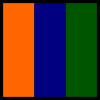King's Own Royal Border Regiment
| King's Own Royal Border Regiment | |
|---|---|
|
Badge of the King's Own Royal Border Regiment | |
| Active | 1959–2006 |
| Allegiance |
|
| Branch |
|
| Type | Infantry |
| Role | Line infantry |
| Part of | King's Division |
| Garrison/HQ | Regimental Headquarters, Carlisle Castle |
| Motto(s) | Tried and Valiant, for Duty not Display |
| March | De ye ken John Peel |
| Anniversaries | 28 October Arroyo Day Commemorates an action in Spain when the 34th Foot captured the Drums of their French opposite numbers. |
| Insignia | |
| Tactical Recognition Flash |
 |
The King's Own Royal Border Regiment was an infantry regiment of the British Army in existence from 1959 until 2006, and was part of the King's Division. It was formed at Barnard Castle on 1st October 1959 through the amalgamation of the King's Own Royal Regiment (Lancaster) and the Border Regiment. The official abbreviated form of the regimental title was 'KINGS OWN BORDER'.
History
The regiment's earliest forebears were the 4th, or Kings Own Regiment of Foot, formed 13 July 1680 as the 2nd Tangier Regiment, also known as 'Charles Earl of Plymouth's Regiment of Foot for Tangiers', being the fourth regiment of foot in seniority in the British Army.[1]
The 34th (Cumberland) and 55th (Westmorland) Regiments of Foot were formed later in 1705 and 1755, respectively.[2] In 1881 they amalgamated to form the Border Regiment.[2]
The 1 October 1959 amalgamated regiment preserved traditions of the previous three regiments (4th, 34th and 55th). Every 28 October, the regiment would celebrate "Arroyo Day" by parading the French drums and French drum major's mace captured during the Peninsular War in 1811. They had been taken intact in the Battle of Arroyo dos Molinos from the French 34e Régiment de Ligne on 28 October 1811.[3]
The regiment saw a great deal of service in Northern Ireland during the troubles. The regiment was twice awarded the Wilkinson Sword of Peace for work in both Derry and Bosnia.[4]
In 2004, as part of the restructuring of the infantry, it was announced that the King's Own Royal Border Regiment would amalgamate with the King's Regiment and the Queen's Lancashire Regiment to form the new Duke of Lancaster's Regiment (King's Lancashire and Border). The Regiment's final act was to serve in Iraq between 2005 and 2006.[5] The new regiment was formed on 1 July 2006, with the Kings Own Royal Border Regiment forming the 3rd Battalion.[6]
Archives of the regiment are preserved in Cumbria's Museum of Military Life at Carlisle Castle.[7]
Colonels-in-Chief
- 1977: HRH Princess Alexandra; The Hon. Angus Ogilvy, LG, GCVO
Regimental Colonels
Regimental Colonels have been:[8]
- 1959–1961: Maj-Gen. Valentine Blomfield, CB, DSO (from Border Regiment)
- 1961–1971: Lt-Gen. Richard Neville Anderson, CB, CBE, DSO
- 1971–1981: Gen. Sir William Norman Roy Scotter, KCB, OBE, MC
- 1981–1988: Maj-Gen. David Edwin Miller, CB, CBE, MC
- 1988–2004: Maj-Gen. Robert John Hodges, CB, OBE
- 2004–2006: Col. Michael Trevor Griffiths
*2006: Regiment amalgamated with The King's Regiment and The Queen's Lancashire Regiment to form The Duke of Lancaster's Regiment (King's, Lancashire and Border)
References
- ↑ "17th century". King's Own Royal Regiment Museum. Retrieved 20 May 2014.
- 1 2 Beckett, p. 29
- ↑ "Duke of Lancaster's Regiment: Regimental History" (PDF). Ministry of Defence. p. 6. Retrieved 20 May 2014.
- ↑ "Duke of Lancaster's Regiment: Regimental History" (PDF). Ministry of Defence. p. 21-22. Retrieved 20 May 2014.
- ↑ "King's Own Royal Border Regiment". Cumbria Museum if Military Life. Retrieved 20 May 2014.
- ↑ "Duke of Lancaster's Regiment". Retrieved 26 April 2014.
- ↑ "Cumbria's Museum of Military Life". Retrieved 19 July 2015.
- ↑ "The King's Own Royal Border Regiment". regiment.org. Retrieved 18 October 2016.
Sources
- Beckett, Ian (2003). Discovering English County Regiments. Shire. ISBN 978-0747805069.
Further reading
- Eastwood, Stuart (2006). Lion and Dragons: An Illustrated History of The King's Own Royal Border Regiment 1959-2006. ISBN 1-85794-279-5.
External links
- King's Own Royal Border Regiment at regiments.org
- Get in Get Out and Get Away - Memoirs of a National Serviceman who served with the KORBR in the Cameroons
- Donnelly, P. "The King's Own Royal Regiment (Lancaster)". Retrieved 7 November 2007.
- "Cumbria's Museum of Military Life".
